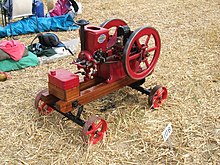This article relies largely or entirely on a single source. (January 2010) |

1917 Amanco 2+1⁄4 hp (1.7 kW) 'Hired Man'
A hit-and-miss engine or Hit 'N' Miss is a type of stationary internal combustion engine that is controlled by a governor to only fire at a set speed. They are usually 4-stroke, but 2-stroke versions were also made. It was conceived in the late 19th century and produced by various companies from the 1890s through approximately the 1940s. The name comes from the speed control on these engines: they fire ("hit") only when operating at or below a set speed, and cycle without firing ("miss") when they exceed their set speed. This is as compared to the "throttle-governed" method of speed control. The sound made when the engine is running without a load is a distinctive "Snort POP whoosh whoosh whoosh whoosh snort POP" as the engine fires and then coasts until the speed decreases and it fires again to maintain its average speed. The snorting is caused by the atmospheric intake valve used on many of these engines.
Many engine manufacturers made hit-and-miss engines during their peak use—from approximately 1910 through the early 1930s, when more modern designs began to replace them. Some of the largest engine manufacturers were Stover, Hercules, International Harvester (McCormick Deering), John Deere (Waterloo Engine Works), Maytag, and Fairbanks Morse.
In the Canadian Atlantic Provinces, primarily in Newfoundland, these engines were known, in colloquial conversation, as "Make-and-Break" engines. The main usage here was to drive traditional skiff style utility and fishing boats.